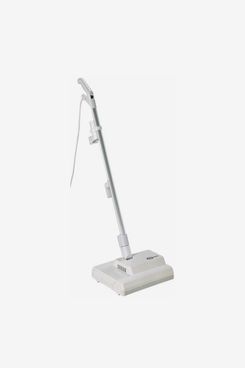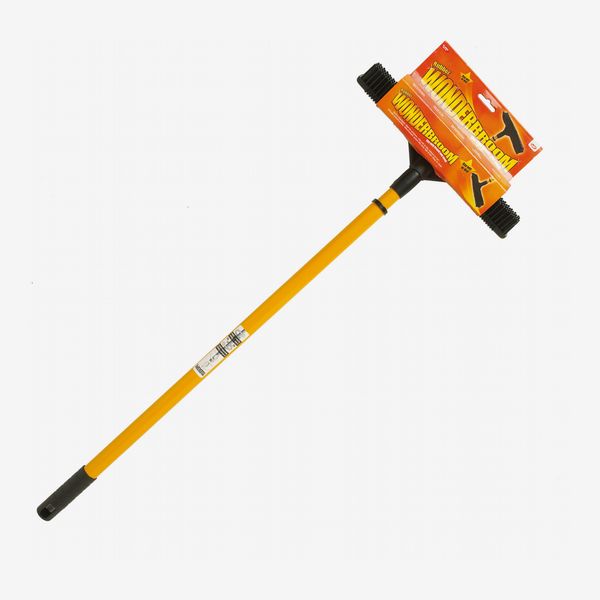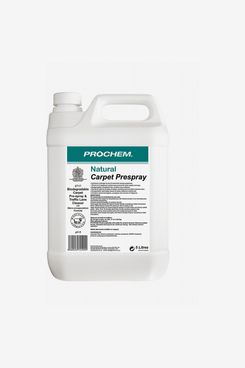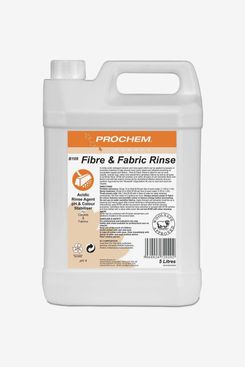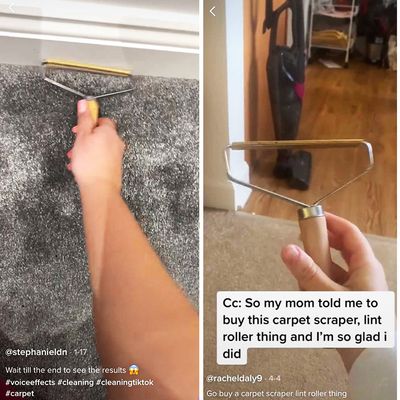
They say you can learn a lot about someone by the content their TikTok algorithm generates for them. On a typical evening, my “For You” page (FYP) is usually a combo of pick ’n’ mix businesses packing up highly specific orders, housing-renovation projects by burly Scottish men, and the comings and goings of Harpo, a sea lion who lives in an aquarium in Long Beach, California. Fittingly for someone who has his own German shower vacuum, there’s a lot of cleaning content, too.
But to be perfectly honest, there isn’t a great deal on CleanTok you haven’t already seen on Mrs. Hinch’s Instagram account. The most popular videos take advantage of TikTok’s penchant for colourful, arresting content — just last week, I saw a woman mixing blue and pink bleaches to give her toilet bowl a sort of candy-striped coating before she scrubbed it. However, there’s one trend that feels like it’s following me around: people scraping their carpets and rugs to get all the dirt out of them.
A typical video will see someone press the scraper (which looks like a cross between a lint roller and a shower squeegee) into either a carpet or a rug and drag it along in a long, sweeping motion before holding the device up to the camera to show off the dirt, fibres, dust, and gunk that have collected on the end. It is incredibly satisfying: like pimple-popping your soft furnishings.
I saw my first carpet-scraping video in February by the U.K. user @Lopwort (he was actually doing it after seeing an American user do it first). His original video now has 4.3 million views, and there’s a ton of copycats doing likewise under both the #CarpetScraper and #TikTokMadeMeBuyIt hashtags. But the more videos I watched, the more I wondered, Was this actually good for your carpets? The thick, scraping noise almost sounded like Velcro being ripped, and as I browsed scrapers on Amazon (I am nothing if not a sucker for a trend), I noticed the tiny little spikes dotted along most of the scrapers, like acupressure mats.
Before I bought a scraper of my own, I decided to call up some cleaning experts to see if they knew anything about carpet-scraping and whether it could cause any damage to carpets or rugs. My first port of call was three luxury London hotels — I figured they would be cleaning their carpets to an immaculate standard as they prepared to open to customers again. First, I spoke to the Mandarin Oriental hotel in Hyde Park, but they got back to me within hours saying they’d be unable to help. Undeterred, I called up both the Dorchester and 45 Park Lane to see if their teams could shed any light on the phenomenon. Their response was the same.
Soon, I felt like Carrie Mathison, the agent played by Claire Danes in Homeland: furiously staring at a wall of clues, unable to see the bigger picture. The temptation to buy a scraper myself and just run it along my Ikea rug was like an itch I couldn’t scratch. Just when I was beginning to give up, I got a response from Pavel Petrov, a quality-control officer at Fantastic Services, a professional-cleaning company in the U.K. He had good and bad news.
The good news: I was right. The bad news: Carpet-scraping is definitely bad for your carpets. “Carpet-scraping will definitely damage your carpet, even if it is being done just two or three times,” Petrov explained. ‘The reason is you are scraping not only the small hairs and dust [on the carpet] but also scraping some of the fibre from the carpet, too. Eventually, the carpet will be permanently damaged,” he said ominously.
I asked him what professional cleaners do to keep carpets clean, and he pointed me to the Sebo Duo agitator machine, which is used after cleaners have pre-sprayed the carpet: “It is basically doing the same thing; not only is it helping to apply the detergents deep into the fabric in order to fight stains better, but it deals with small hair or dust, which cannot be taken away with a hot-water extraction machine afterwards.”
The Sebo Duo agitator uses two rotating brushes to separate carpet fibres, which allows a detergent to penetrate deeper into the carpet. The vacuum-style suction then cleans the carpet. Petrov told me these are typically used by professionals, though there’s no reason you couldn’t buy one online.
However, should you want a cheaper alternative, the best manual carpet agitators typically use rubber bristles to gently tease apart carpet or rug fibres. Contributor Sam Higgins wrote about this JML one, which “can reach hard-to-get places but is easily twisted into a more compact form — perfect for places with limited storage, like my cosy flat.”
Additionally, Zdravko Dimitrov, a lead technician at Fantastic Services, suggested these upholstery cleaners from Prochem. Prochem’s industrial Natural Carpet Prespray is more environmentally friendly than most, thanks to ecosurfactants and biodegradable ingredients.
“Both of them smell great and do a fantastic job when it comes to general dirt and high-traffic carpet areas,” said Dimitrov. “The Prespray has a lower pH in order to tackle oily spots more easily, while both of them are great for use on wool carpets.”
The Strategist UK is designed to surface the most useful, expert recommendations for things to buy across the vast e-commerce landscape. Read about who we are and what we do here. Our editors update links when possible, but note that deals can expire and all prices are subject to change.
